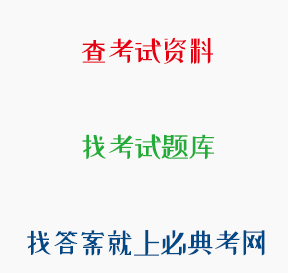正确答案: C
The early prerequisites students mastered.
题目:请阅读Passage 1,完成1~5小题。 Passage 1 Today's adults grew up in schools designed to sort us into the various segments of our social and economic system.The amount of time available to learn was fixed: one year per grade.The amount learned by the end of that time was free to vary: some ofus leamed a great deal; some,very little.As we advanced through the grades,those who had learned a great deal in previous grades continued to build on those foundations.Those who had failed to master the early prerequisites within the allotted time failed to learn that which followed.After 12 or 13 years of cumulative treatment of this kinD.we were,in effect,spread along an achievement continuum that was ultimately reflected in each student's rank in class upon graduation. From the very earliest grades,some students learned a great deal very quickly and consistently scored high on assessments.The emotional effect of this was to help them to see themselves as capable learners,and so these students became increasingly confident in school.That confidence gave them the inner emotional strength to take the risk of striving for more success because they believed that success was within their reach.Driven forward by this optimism,these students continued to try harD.and that effort continued to result in success for them.They became the academic and emotional winners.Notice that the trigger for their emotional strength and their learning success was their perception of their success on formal and informal assessments. But there were other students who didn't fare so well.They scored very low on tests,beginning in the earliest grades.The emotional effect was to cause them to question their own capabilities as learners.They began to lose confidence,which,in turn,deprived them of the emotional reserves needed to continue to take risks.As their motivation warneD.of course,their performance <u>plummeted</u>.These students embarked on what they believed to be an irreversible slide toward inevitable failure and lost hope.Once again,the emotional trigger for their decision not to try was their perception of their performance on assessments. Consider the reality-indeed.the paradox-of the schools in which we were reared.If some students worked hard and learned a lot,that was a positive result,and they would finish high in the rank order.But if some students gave up in hopeless failure,that was an acceptable result,too, because they would occupy places very low in the rank order.Their achievement results fed into the implicit mission of schools: the greater the spread of achievement among students,the more it reinforced the rank order.This is why,if some students gave up and stopped trying (even dropped out of school),that was regarded as the student's problem,not the teacher's or the school's. Once again,please notice who is using test results to decide whether to strive for excellence or give up in hopelessness.The "data-based decision makers" in this process are students themselves.Students are deciding whether success is within or beyond reach,whether the learning is worth the required effort,and so whether to try or not.The critical emotions underpinning the decision making process include anxiety,fear of failure,uncertainty,and unwillingness to take risks-all triggered by students' perceptions of their own capabilities as reflected in assessment results. Some students responded to the demands of such environments by working hard and learning a great deal.Others controlled their anxiety by giving up and not caring.The result for them is exactly the opposite of the one society wants.Instead of leaving no child behinD.these practices,in effect,drove down the achievement of at least as many students as they successfully elevated.And the evidence suggests that the downside victims are more frequently members of particular socioeconomic and ethnic minorities.
解析:细节题。根据文章第一段中的“…those who had learned a great deal in previous grades continued to build on those foundations.….spread along an achievement continuum that was ultimately reflected in each student's rank in class upon graduation.”可知,在之前的学习中掌握较多内容的学生继续在已有基础上学习,没有在规定时间内掌握先决条件的人则无法继续学习,经过长期累积,学生的成就最终反映在他们各自的排名上。所以决定学生成就的是他们早期掌握的内容。故本题选C。
学习资料的答案和解析:
间接再现
From the last paragraph we know that________.
forgetfulness is a response to learning
- When a teacher asks students to discuss how the writer's ide
- 依据《中华人民共和国未成年人保护法》,依法设置的专门学校(
- 如果学生要学习的知识内容比较复杂、结构化程度很高,又必须在较
- 指出下列推理中正确的一项是:( )
- 以下不属于教师的义务的是( )。
- 教师资格证-高中英语2022冲刺密卷答案解析(06.13)
- 学生干部选举前,有的家长给班主任陈老师送来礼物请求照顾,陈老
- 课堂提问需要遵循哪些原则?课堂提问能提高学生哪方面的能力?
- 教师让四名学生每人去拿一只桌球,不论什么颜色。学生拿了球后,
- 材料: 创新是一个人人熟知的名字,但创新到底意味着什么?

 川公网安备 51012202001360号
川公网安备 51012202001360号